Jianchao Tan
MaskPrune: Mask-based LLM Pruning for Layer-wise Uniform Structures
Feb 19, 2025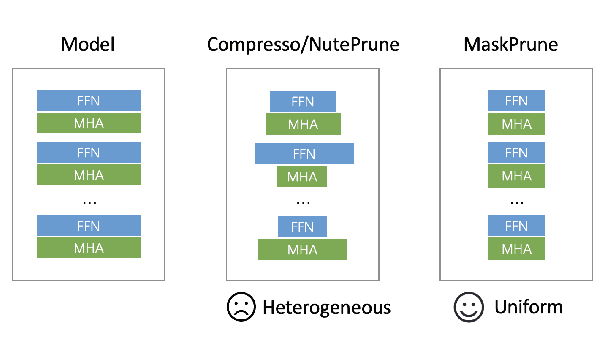

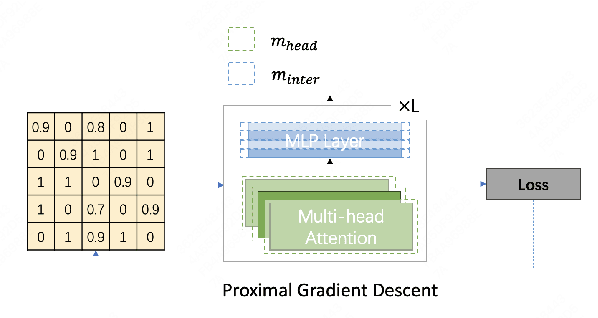

Abstract:The remarkable performance of large language models (LLMs) in various language tasks has attracted considerable attention. However, the ever-increasing size of these models presents growing challenges for deployment and inference. Structured pruning, an effective model compression technique, is gaining increasing attention due to its ability to enhance inference efficiency. Nevertheless, most previous optimization-based structured pruning methods sacrifice the uniform structure across layers for greater flexibility to maintain performance. The heterogeneous structure hinders the effective utilization of off-the-shelf inference acceleration techniques and impedes efficient configuration for continued training. To address this issue, we propose a novel masking learning paradigm based on minimax optimization to obtain the uniform pruned structure by optimizing the masks under sparsity regularization. Extensive experimental results demonstrate that our method can maintain high performance while ensuring the uniformity of the pruned model structure, thereby outperforming existing SOTA methods.
C2T: A Classifier-Based Tree Construction Method in Speculative Decoding
Feb 19, 2025
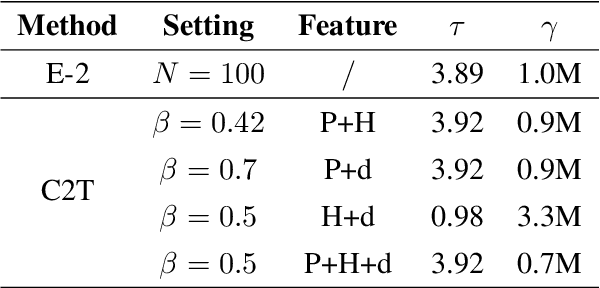

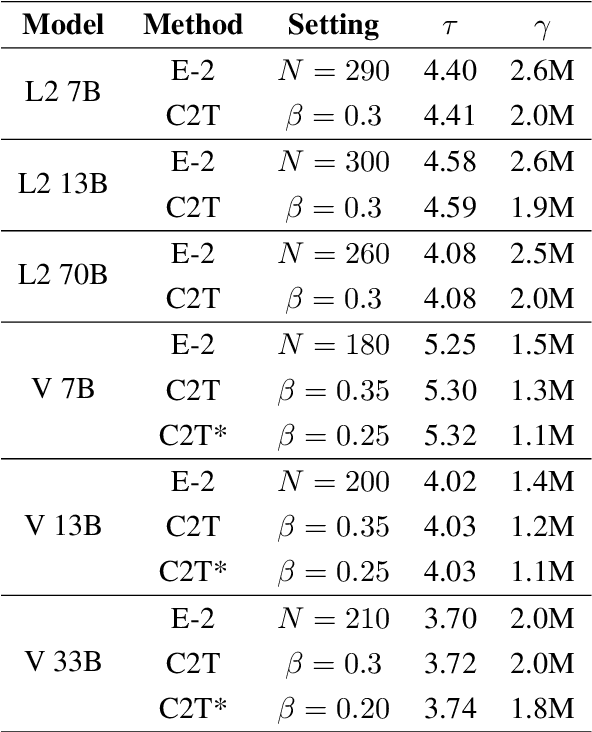
Abstract:The growing scale of Large Language Models (LLMs) has exacerbated inference latency and computational costs. Speculative decoding methods, which aim to mitigate these issues, often face inefficiencies in the construction of token trees and the verification of candidate tokens. Existing strategies, including chain mode, static tree, and dynamic tree approaches, have limitations in accurately preparing candidate token trees for verification. We propose a novel method named C2T that adopts a lightweight classifier to generate and prune token trees dynamically. Our classifier considers additional feature variables beyond the commonly used joint probability to predict the confidence score for each draft token to determine whether it is the candidate token for verification. This method outperforms state-of-the-art (SOTA) methods such as EAGLE-2 on multiple benchmarks, by reducing the total number of candidate tokens by 25% while maintaining or even improving the acceptance length.
PrefixKV: Adaptive Prefix KV Cache is What Vision Instruction-Following Models Need for Efficient Generation
Dec 04, 2024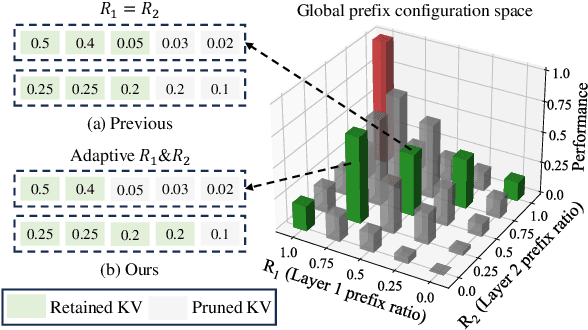

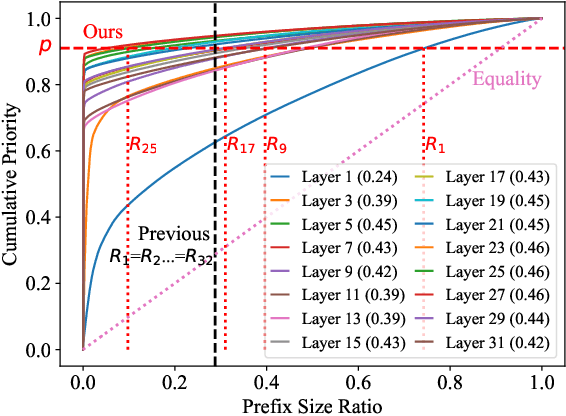

Abstract:Recently, large vision-language models (LVLMs) have rapidly gained popularity for their strong generation and reasoning capabilities given diverse multimodal inputs. However, these models incur significant computational and memory overhead during inference, which greatly hinders the efficient deployment in practical scenarios. The extensive key-value (KV) cache, necessitated by the lengthy input and output sequences, notably contributes to the high inference cost. Based on this, recent works have investigated ways to reduce the KV cache size for higher efficiency. Although effective, they generally overlook the distinct importance distributions of KV vectors across layers and maintain the same cache size for each layer during the next token prediction. This results in the significant contextual information loss for certain layers, leading to notable performance decline. To address this, we present PrefixKV. It reframes the challenge of determining KV cache sizes for all layers into the task of searching for the optimal global prefix configuration. With an adaptive layer-wise KV retention recipe based on binary search, the maximum contextual information can thus be preserved in each layer, facilitating the generation. Extensive experiments demonstrate that our method achieves the state-of-the-art performance compared with others. It exhibits superior inference efficiency and generation quality trade-offs, showing promising potential for practical applications. Code is available at \url{https://github.com/THU-MIG/PrefixKV}.
EPS-MoE: Expert Pipeline Scheduler for Cost-Efficient MoE Inference
Oct 16, 2024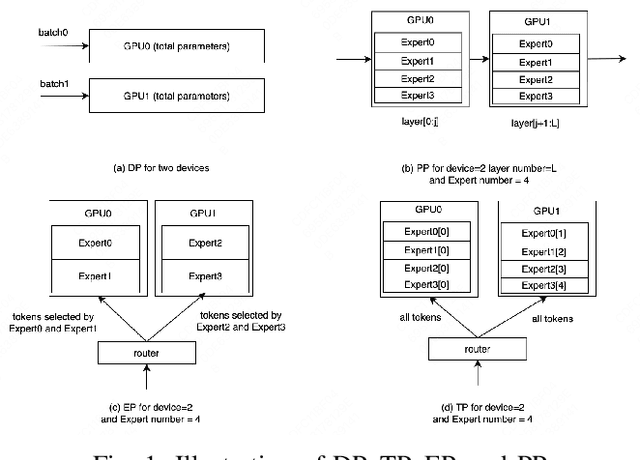
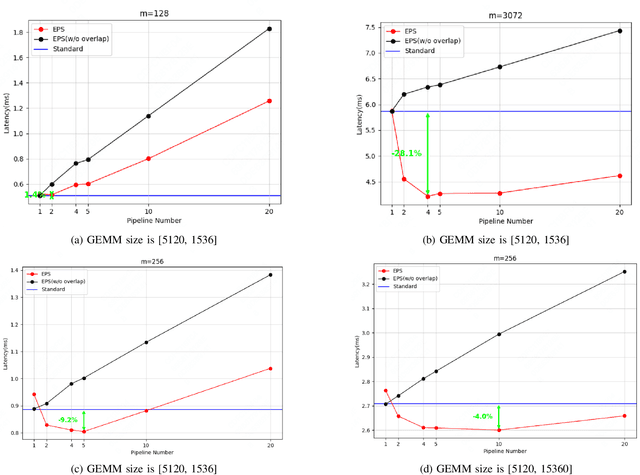

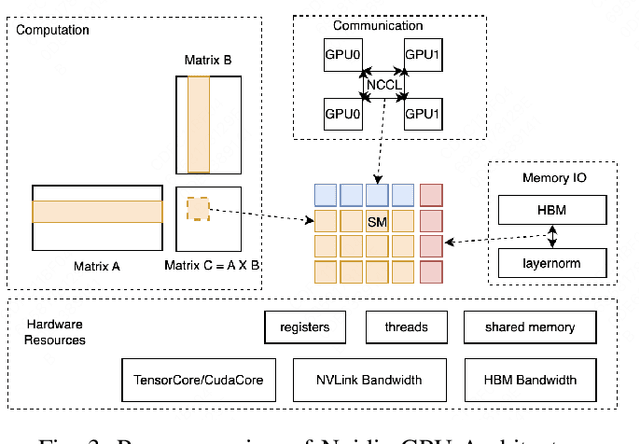
Abstract:Large Language Model (LLM) has revolutionized the field of artificial intelligence, with their capabilities expanding rapidly due to advances in deep learning and increased computational resources. The mixture-of-experts (MoE) model has emerged as a prominent architecture in the field of LLM, better balancing the model performance and computational efficiency. MoE architecture allows for effective scaling and efficient parallel processing, but the GEMM (General Matrix Multiply) of MoE and the large parameters introduce challenges in terms of computation efficiency and communication overhead, which becomes the throughput bottleneck during inference. Applying a single parallelism strategy like EP, DP, PP, etc. to MoE architecture usually achieves sub-optimal inference throughput, the straightforward combinations of existing different parallelisms on MoE can not obtain optimal inference throughput yet. This paper introduces EPS-MoE, a novel expert pipeline scheduler for MoE that goes beyond the existing inference parallelism schemes. Our approach focuses on optimizing the computation of MoE FFN (FeedForward Network) modules by dynamically selecting the best kernel implementation of GroupGemm and DenseGemm for different loads and adaptively overlapping these computations with \textit{all2all} communication, leading to a substantial increase in throughput. Our experimental results demonstrate an average 21% improvement in prefill throughput over existing parallel inference methods. Specifically, we validated our method on DeepSeekV2, a highly optimized model claimed to achieve a prefill throughput of 100K tokens per second. By applying EPS-MoE, we further accelerated it to at least 120K tokens per second.
CountFormer: Multi-View Crowd Counting Transformer
Jul 02, 2024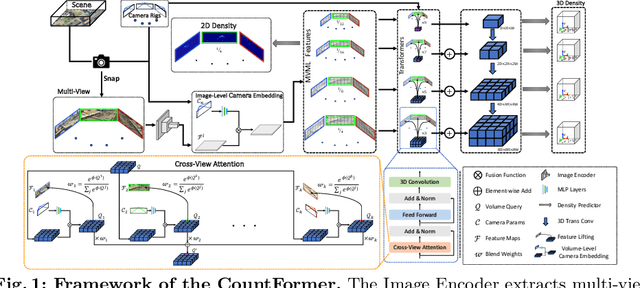

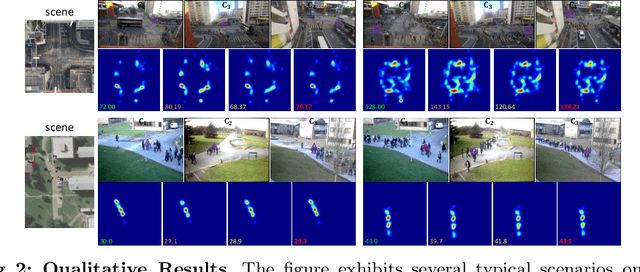
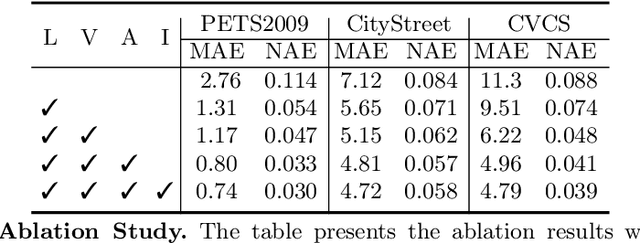
Abstract:Multi-view counting (MVC) methods have shown their superiority over single-view counterparts, particularly in situations characterized by heavy occlusion and severe perspective distortions. However, hand-crafted heuristic features and identical camera layout requirements in conventional MVC methods limit their applicability and scalability in real-world scenarios.In this work, we propose a concise 3D MVC framework called \textbf{CountFormer}to elevate multi-view image-level features to a scene-level volume representation and estimate the 3D density map based on the volume features. By incorporating a camera encoding strategy, CountFormer successfully embeds camera parameters into the volume query and image-level features, enabling it to handle various camera layouts with significant differences.Furthermore, we introduce a feature lifting module capitalized on the attention mechanism to transform image-level features into a 3D volume representation for each camera view. Subsequently, the multi-view volume aggregation module attentively aggregates various multi-view volumes to create a comprehensive scene-level volume representation, allowing CountFormer to handle images captured by arbitrary dynamic camera layouts. The proposed method performs favorably against the state-of-the-art approaches across various widely used datasets, demonstrating its greater suitability for real-world deployment compared to conventional MVC frameworks.
USDC: Unified Static and Dynamic Compression for Visual Transformer
Oct 17, 2023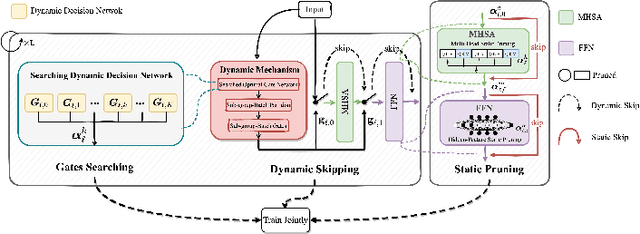
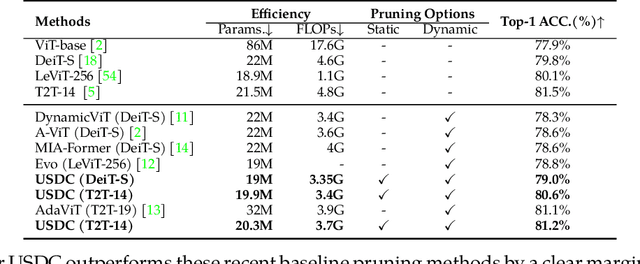
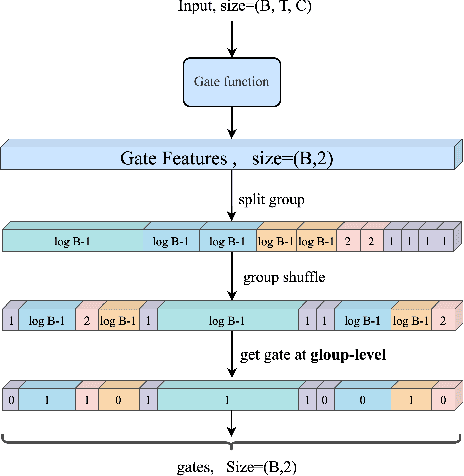
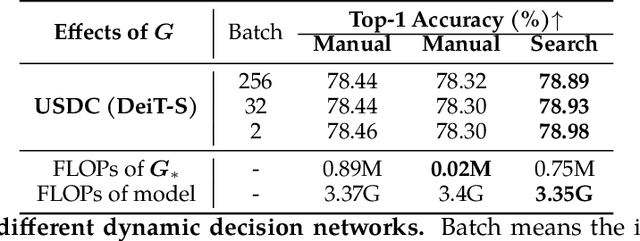
Abstract:Visual Transformers have achieved great success in almost all vision tasks, such as classification, detection, and so on. However, the model complexity and the inference speed of the visual transformers hinder their deployments in industrial products. Various model compression techniques focus on directly compressing the visual transformers into a smaller one while maintaining the model performance, however, the performance drops dramatically when the compression ratio is large. Furthermore, several dynamic network techniques have also been applied to dynamically compress the visual transformers to obtain input-adaptive efficient sub-structures during the inference stage, which can achieve a better trade-off between the compression ratio and the model performance. The upper bound of memory of dynamic models is not reduced in the practical deployment since the whole original visual transformer model and the additional control gating modules should be loaded onto devices together for inference. To alleviate two disadvantages of two categories of methods, we propose to unify the static compression and dynamic compression techniques jointly to obtain an input-adaptive compressed model, which can further better balance the total compression ratios and the model performances. Moreover, in practical deployment, the batch sizes of the training and inference stage are usually different, which will cause the model inference performance to be worse than the model training performance, which is not touched by all previous dynamic network papers. We propose a sub-group gates augmentation technique to solve this performance drop problem. Extensive experiments demonstrate the superiority of our method on various baseline visual transformers such as DeiT, T2T-ViT, and so on.
ASP: Automatic Selection of Proxy dataset for efficient AutoML
Oct 17, 2023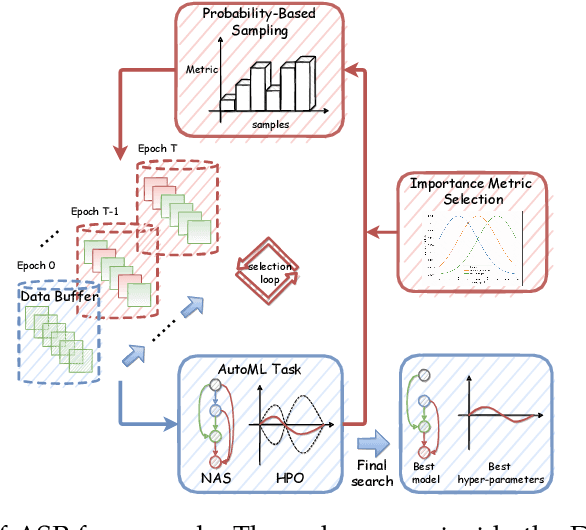
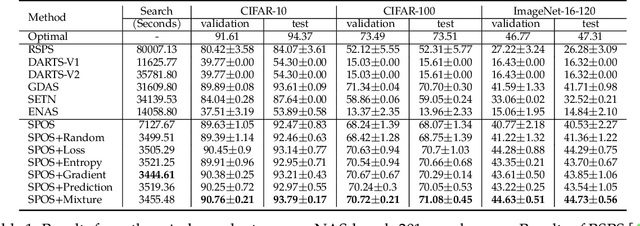
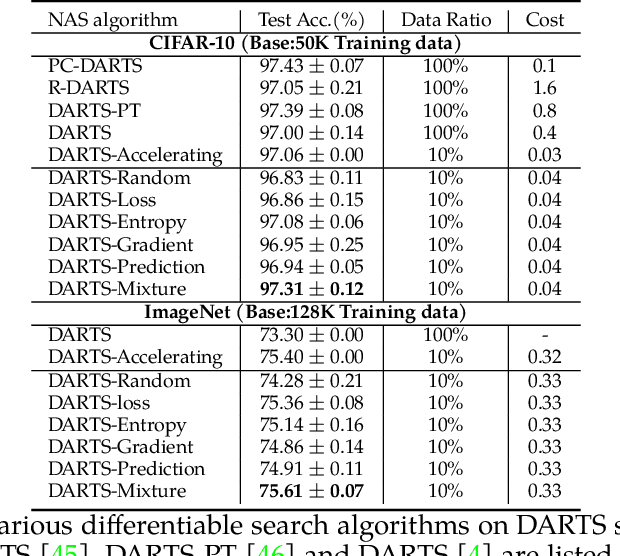

Abstract:Deep neural networks have gained great success due to the increasing amounts of data, and diverse effective neural network designs. However, it also brings a heavy computing burden as the amount of training data is proportional to the training time. In addition, a well-behaved model requires repeated trials of different structure designs and hyper-parameters, which may take a large amount of time even with state-of-the-art (SOTA) hyper-parameter optimization (HPO) algorithms and neural architecture search (NAS) algorithms. In this paper, we propose an Automatic Selection of Proxy dataset framework (ASP) aimed to dynamically find the informative proxy subsets of training data at each epoch, reducing the training data size as well as saving the AutoML processing time. We verify the effectiveness and generalization of ASP on CIFAR10, CIFAR100, ImageNet16-120, and ImageNet-1k, across various public model benchmarks. The experiment results show that ASP can obtain better results than other data selection methods at all selection ratios. ASP can also enable much more efficient AutoML processing with a speedup of 2x-20x while obtaining better architectures and better hyper-parameters compared to utilizing the entire dataset.
Unified Language-Vision Pretraining in LLM with Dynamic Discrete Visual Tokenization
Sep 29, 2023
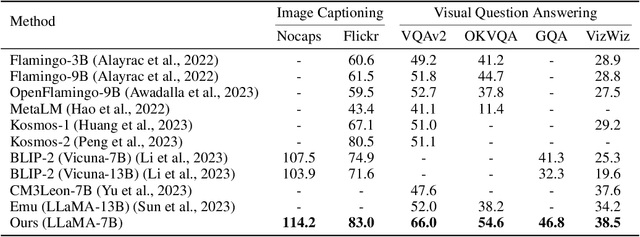

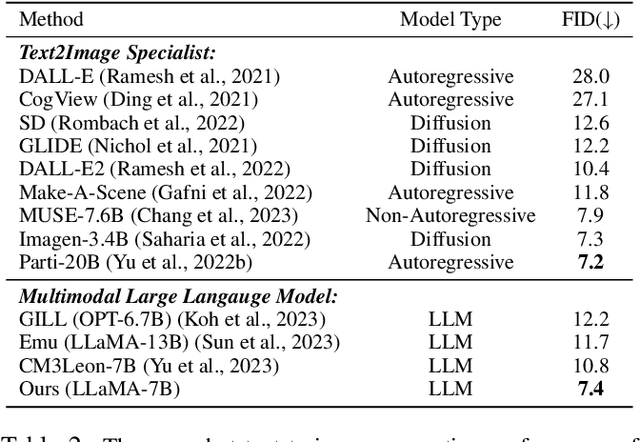
Abstract:Recently, the remarkable advance of the Large Language Model (LLM) has inspired researchers to transfer its extraordinary reasoning capability to both vision and language data. However, the prevailing approaches primarily regard the visual input as a prompt and focus exclusively on optimizing the text generation process conditioned upon vision content by a frozen LLM. Such an inequitable treatment of vision and language heavily constrains the model's potential. In this paper, we break through this limitation by representing both vision and language in a unified form. Specifically, we introduce a well-designed visual tokenizer to translate the non-linguistic image into a sequence of discrete tokens like a foreign language that LLM can read. The resulting visual tokens encompass high-level semantics worthy of a word and also support dynamic sequence length varying from the image. Coped with this tokenizer, the presented foundation model called LaVIT can handle both image and text indiscriminately under the same generative learning paradigm. This unification empowers LaVIT to serve as an impressive generalist interface to understand and generate multi-modal content simultaneously. Extensive experiments further showcase that it outperforms the existing models by a large margin on massive vision-language tasks. Our code and models will be available at https://github.com/jy0205/LaVIT.
SHARK: A Lightweight Model Compression Approach for Large-scale Recommender Systems
Aug 18, 2023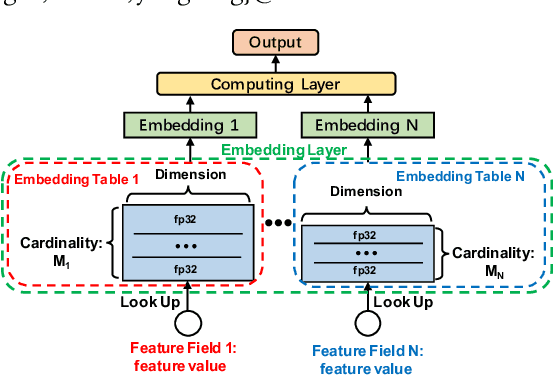


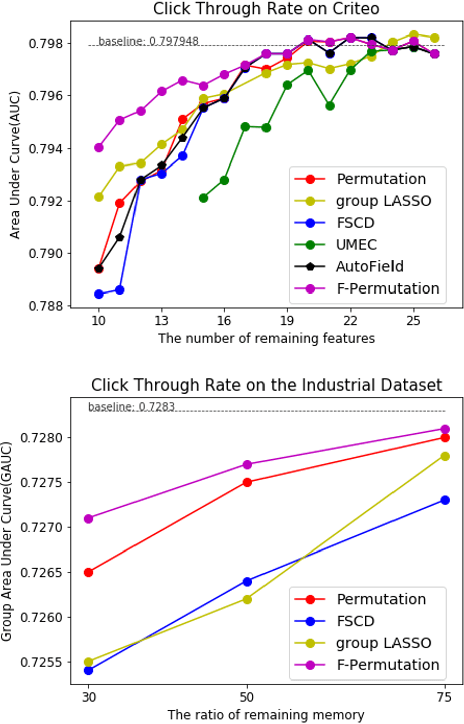
Abstract:Increasing the size of embedding layers has shown to be effective in improving the performance of recommendation models, yet gradually causing their sizes to exceed terabytes in industrial recommender systems, and hence the increase of computing and storage costs. To save resources while maintaining model performances, we propose SHARK, the model compression practice we have summarized in the recommender system of industrial scenarios. SHARK consists of two main components. First, we use the novel first-order component of Taylor expansion as importance scores to prune the number of embedding tables (feature fields). Second, we introduce a new row-wise quantization method to apply different quantization strategies to each embedding. We conduct extensive experiments on both public and industrial datasets, demonstrating that each component of our proposed SHARK framework outperforms previous approaches. We conduct A/B tests in multiple models on Kuaishou, such as short video, e-commerce, and advertising recommendation models. The results of the online A/B test showed SHARK can effectively reduce the memory footprint of the embedded layer. For the short-video scenarios, the compressed model without any performance drop significantly saves 70% storage and thousands of machines, improves 30\% queries per second (QPS), and has been deployed to serve hundreds of millions of users and process tens of billions of requests every day.
Resource Constrained Model Compression via Minimax Optimization for Spiking Neural Networks
Aug 09, 2023Abstract:Brain-inspired Spiking Neural Networks (SNNs) have the characteristics of event-driven and high energy-efficient, which are different from traditional Artificial Neural Networks (ANNs) when deployed on edge devices such as neuromorphic chips. Most previous work focuses on SNNs training strategies to improve model performance and brings larger and deeper network architectures. It is difficult to deploy these complex networks on resource-limited edge devices directly. To meet such demand, people compress SNNs very cautiously to balance the performance and the computation efficiency. Existing compression methods either iteratively pruned SNNs using weights norm magnitude or formulated the problem as a sparse learning optimization. We propose an improved end-to-end Minimax optimization method for this sparse learning problem to better balance the model performance and the computation efficiency. We also demonstrate that jointly applying compression and finetuning on SNNs is better than sequentially, especially for extreme compression ratios. The compressed SNN models achieved state-of-the-art (SOTA) performance on various benchmark datasets and architectures. Our code is available at https://github.com/chenjallen/Resource-Constrained-Compression-on-SNN.
 Add to Chrome
Add to Chrome Add to Firefox
Add to Firefox Add to Edge
Add to Edge